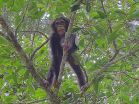(Press-News.org) Researchers from the National University of Singapore (NUS) have discovered a new reproductive mode in frogs and toads - breeding and laying direct developing eggs in live bamboo with narrow openings - which was observed in the white spotted bush frog (Raorchestes chalazodes). This critically endangered frog is currently only one of two species known to adopt this novel reproductive strategy. The findings were published in The Linnean Society of London's Biological Journal of the Linnean Society, in October 2014.
Life history strategies to increase reproductive success are termed as reproductive modes. Frogs and toads currently exhibit 40 known reproductive modes, including 17 aquatic modes and 23 terrestrial modes. This study reports the discovery of the 41st reproductive mode which is different from all other known modes – breeding in live bamboo with narrow slits through which adults enter and deposit direct developing eggs and provide parental care. Direct-developing eggs are eggs that hatch as frogs directly. The species of frogs that exhibit this behaviour, R. chalazodes, was thought to be extinct for over 100 years until it was rediscovered recently in the wet evergreen forests of the Kalakad Mundanthurai Tiger Reserve in the Western Ghats. This biodiversity hotspot of India is listed as a UNESCO World Heritage Site.
In this study, Mr Seshadri K S, a PhD student, and Assistant Professor David Bickford from the Department of Biological Sciences at the NUS Faculty of Science, discovered the reproductive strategy of R. chalazodes. Mr Seshadri observed that adult male frogs enter hollow internodes of the flute bamboo Ochlandra travancorica where they vocalise to attract mates. They make their way into the bamboo through a small opening, possibly made by insects. Female frogs are attracted to the calls and follow suit, laying about 5 to 8 eggs inside the bamboo. Other females may also choose to mate with the male frog and deposit egg clutches in the bamboo. The male stays in the bamboo to take care of the eggs, which develop directly into froglets.
Although the adult frog is small, under 25 millimetres in length, it enters the bamboo with considerable resistance as the narrow openings are often less than 5 to 10 millimetres long and 3 to 4 millimetres wide. The researchers observed that that R. chalazodes only breeds in bamboo that have openings at the base of the internode as those with openings at the top would result in collection of water, possibly flooding the eggs or drowning the froglets. The adult males actively search for openings in bamboo and possibly defend territories. They leave the bamboo for a few hours in the evening to feed and return to look after the eggs. The researchers made these findings after conducting field observations over a period of six months between 2009 and 2012.
Asst Prof Bickford said, "This is a significant discovery in two ways. First, it reiterates that natural history observations, often ignored, are fundamental for understanding evolutionary ecology. Second, it sets a theoretical foundation to ask several interesting questions about the diversity of reproductive modes and the evolutionary pathways behind such amazing amphibian behaviors."
The second author of the paper, Dr Gururaja K V from the Centre for Infrastructure, Sustainable Transportation and Urban Planning at the Institute of Science, Bangalore, India, had observed that another species of frogs, known as the Ochlandra reed frog (Raorchestes ochlandrae), breeds in internodes of bamboo. While the geographic ranges of these two species do not overlap and nesting occurs inside different species of bamboo, the reproductive mode is comparable. R. ochlandrae was previously ascribed to a reproductive mode characterised by direct developing eggs deposited in a nest above ground or in the trees. In this study, the researchers did not observe any nest-making behaviour and thus, the mode was reclassified to be the same as R. chalazodes.
The study is timely as R. chalazodes is currently critically endangered with small populations occurring in fewer than five localities. As this species only breeds in bamboo, unregulated overharvesting of bamboo for paper and pulp may destroy breeding habitats and have a negative impact on the long-term viability of populations. It is critical to conduct more studies on these unique frogs, in particular, those that look into developing frog-friendly harvesting techniques in order to conserve them.
Mr Seshadri, the lead author, said, "Amphibians are among the most threatened creatures on earth and yet, we know very little about them. I was enthralled when we observed this behavior and it opened a whole new world for me. There are several evolutionary questions that could be answered by studying this fascinating group of frogs. For example, what transpires inside the bamboo internodes is still a mystery. The Western Ghats is a well-known hotspot for amphibian diversity which is facing threats primarily from habitat loss. If we do not initiate conservation efforts, we may lose everything before we even document anything."
Dr Gururaja said, "While species diversity has increased, very little ecological information has been added. The recent discoveries of interesting behaviour such as foot-flagging in the dancing frog (Micrixalus kottigeharensis), and clay nest-building in the potter frog (Nyctibatrachus kumbara) are a case in point that there is much more to be discovered in India and Southeast Asia."
INFORMATION: END
NUS researchers discover for the first time that a rare bush frog breeds in bamboo
Scientists observed this new reproductive mode in critically endangered white spotted bush frogs in South India's Western Ghats
2014-10-28
ELSE PRESS RELEASES FROM THIS DATE:
Fish 'personality' linked to vulnerability to angling
2014-10-28
Individual differences in moving activity in a novel environment are linked to individual differences in vulnerability to angling, according to an experimental study completed at the University of Eastern Finland and the Finnish Game and Fisheries Research Institute. The study used novel, long-term observations of individual behaviour in groups and authentic angling trials to analyse if behaviours predict the vulnerability to fishing in brown trout reared in traditional and enriched hatchery rearing environments. Based on the results, it can be predicted that fishing modifies ...
When faced with higher prices, swimming is the activity most likely to take a dive
2014-10-28
Experts agree that it's a great way of staying fit and healthy at any age, but when faced with higher prices people are likely to swim less often, while other forms of physical activity such as working out or walking are barely affected.
According to a study by Brunel University London's Health Economics Research Group (HERG), swimming is the individual activity that most people would drop if they faced higher prices.
The study included interviews with 1,683 people, 83% of whom took part in physical activity in some form. It found that people facing 10% higher entry ...
Tea and citrus products could lower ovarian cancer risk, new UEA research finds
2014-10-28
Tea and citrus fruits and juices are associated with a lower risk of developing ovarian cancer, according to new research from the University of East Anglia (UEA).
Research published today reveals that women who consume foods containing flavonols and flavanones (both subclasses of dietary flavonoids) significantly decrease their risk of developing epithelial ovarian cancer, the fifth-leading cause of cancer death among women.
The research team studied the dietary habits of 171,940 women aged between 25 and 55 for more than three decades.
The team found that those ...
Generic medications boost adherence to breast cancer therapy
2014-10-28
VIDEO:
A study by Columbia University Medical Center (CUMC) researchers has found that the introduction of generic aromatase inhibitors (the most common type of hormone therapy), which are considerably less expensive...
Click here for more information.
NEW YORK, NY (October 27, 2014)—Although oral hormonal therapy is known to substantially reduce breast cancer recurrence in women with hormone receptor–positive tumors, about one-half of patients fail to take their medications ...
Chimps plan ahead for a good breakfast
2014-10-28
New research by the University of California, Davis, shows that chimpanzees plan ahead, and sometimes take dangerous risks, to get to the best breakfast buffet early.
The study co-authored by Leo Polansky, an associate researcher in the UC Davis anthropology department, reveals that chimpanzees will find a place to sleep en route to breakfast sites and risk travel in the dark when predators are active to obtain more desired, less abundant fruits such as figs. The study is being published by the Proceedings of the National Academy of Sciences of the United States of America.
"As ...
Replacing saturated fat with polyunsaturated fat linked with lower risk of heart disease
2014-10-28
Boston, MA — People who swap 5% of the calories they consume from saturated fat sources such as red meat and butter with foods containing linoleic acid—the main polyunsaturated fat found in vegetable oil, nuts, and seeds—lowered their risk of coronary heart disease (CHD) events by 9% and their risk of death from CHD by 13%, according to a new study led by Harvard School of Public Health (HSPH) researchers. Substitution of 5% of calories from carbohydrate with linoleic acid was associated with similar reductions in risk of heart disease.
"There has been ...
Don't bet on stinginess to keep stress low
2014-10-28
Is generosity less stressful than being stingy?
QUT research, published in scientific journal Public Library of Science (PLOS) ONE, examined the physiological reactions of participants in a financial bargaining game and found that not only those receiving relatively low offers experienced stress but also those that make low offers, when compared to people who made more generous offers.
Participants were asked to play the Ultimatum Bargaining Game, in which players decide how to divide a sum of money given to them.
Player one (the proposer) proposes how to divide ...
Spices and herbs: Improving public health through flavorful eating -- a call to action
2014-10-28
Spices and herbs can play a significant role in improving America's health by helping to reduce sodium, calorie and fat intake while making healthy eating more appealing, conclude the authors of a scientific supplement published this month in the peer-reviewed journal Nutrition Today.
The publication, entitled Spices and Herbs: Improving Public Health Through Flavorful Eating, is based on the conference proceedings of a Science Summit convened by the McCormick Science Institute in partnership with the American Society for Nutrition in Washington, D.C., on May 20-21, ...
New results from VOICE associates tenofovir gel use with lower HSV-2 risk in women
2014-10-28
CAPE TOWN, October 28, 2014 – The risk of acquiring herpes simplex virus type 2 (HSV-2) was reduced by half among women in the VOICE trial who used a vaginal gel containing the antiretroviral (ARV) drug tenofovir regularly, according to researchers from the U.S. National Institutes of Health-funded Microbicide Trials Network (MTN) who conducted the study. The findings provide additional evidence that tenofovir gel, a product developed to protect against HIV, could potentially help in preventing one of the most prevalent sexually transmitted infections affecting sexually ...
What's in a name? Everything -- if you're a fruit fly
2014-10-28
A global research effort has finally resolved a major biosecurity issue: four of the world's most destructive agricultural pests are actually one and the same.
For twenty years some of the world's most damaging pest fruit flies have been almost impossible to distinguish from each other. The ability to identify pests is central to quarantine, trade, pest management and basic research.
In 2009 a coordinated research effort got underway to definitively answer this question by resolving the differences, if any, between five of the most destructive fruit flies: the Oriental ...
LAST 30 PRESS RELEASES:
Orthopedics can play critical role in identifying intimate partner violence
Worms as particle sweepers
Second spider-parasitic mite described in Brazil
January 2026 issues of APA journals feature new research on autism, pediatric anxiety, psychedelic therapy, suicide prevention and more
Private equity acquired more than 500 autism centers over the past decade, new study shows
New cervical cancer screening guidelines from the US Department of Health and Human Services
Estimated burden of COVID-19 illnesses, medical visits, hospitalizations, and deaths in the US from October 2022 to September 2024
Smartphone use during school hours by US youth
Food insecurity and adverse social conditions tied to increased risk of long COVID in children
Earliest, hottest galaxy cluster gas on record could change our cosmological models
Greenland’s Prudhoe Dome ice cap was completely gone only 7,000 years ago, first GreenDrill study finds
Scientific validity of blue zones longevity research confirmed
Injectable breast ‘implant’ offers alternative to traditional surgeries
Neuroscientists devise formulas to measure multilingualism
New prostate cancer trial seeks to reduce toxicity without sacrificing efficacy
Geometry shapes life
A CRISPR screen reveals many previously unrecognized genes required for brain development and a new neurodevelopmental disorder
Hot flush treatment has anti-breast cancer activity, study finds
Securing AI systems against growing cybersecurity threats
Longest observation of an active solar region
Why nail-biting, procrastination and other self-sabotaging behaviors are rooted in survival instincts
Regional variations in mechanical properties of porcine leptomeninges
Artificial empathy in therapy and healthcare: advancements in interpersonal interaction technologies
Why some brains switch gears more efficiently than others
UVA’s Jundong Li wins ICDM’S 2025 Tao Li Award for data mining, machine learning
UVA’s low-power, high-performance computer power player Mircea Stan earns National Academy of Inventors fellowship
Not playing by the rules: USU researcher explores filamentous algae dynamics in rivers
Do our body clocks influence our risk of dementia?
Anthropologists offer new evidence of bipedalism in long-debated fossil discovery
Safer receipt paper from wood
[Press-News.org] NUS researchers discover for the first time that a rare bush frog breeds in bambooScientists observed this new reproductive mode in critically endangered white spotted bush frogs in South India's Western Ghats




